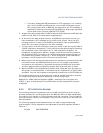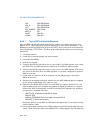
8-24 Vol. 3
MULTIPLE-PROCESSOR MANAGEMENT
The PAT was introduced in the Pentium III processor to enhance the caching charac-
teristics that can be assigned to pages or groups of pages. The PAT mechanism typi-
cally used to strengthen caching characteristics at the page level with respect to the
caching characteristics established by the MTRRs.
Table 11-7 shows the interaction of
the PAT with the MTRRs.
We recommended that software written to run on Intel Core 2 Duo, Intel Atom, Intel
Core Duo, Pentium 4, Intel Xeon, and P6 family processors assume the processor-
ordering model or a weaker memory-ordering model. The Intel Core 2 Duo, Intel
Atom, Intel Core Duo, Pentium 4, Intel Xeon, and P6 family processors do not imple
-
ment a strong memory-ordering model, except when using the UC memory type.
Despite the fact that Pentium 4, Intel Xeon, and P6 family processors support
processor ordering, Intel does not guarantee that future processors will support this
model. To make software portable to future processors, it is recommended that oper
-
ating systems provide critical region and resource control constructs and API’s (appli-
cation program interfaces) based on I/O, locking, and/or serializing instructions be
used to synchronize access to shared areas of memory in multiple-processor
systems. Also, software should not depend on processor ordering in situations where
the system hardware does not support this memory-ordering model.
8.3 SERIALIZING INSTRUCTIONS
The Intel 64 and IA-32 architectures define several serializing instructions. These
instructions force the processor to complete all modifications to flags, registers, and
memory by previous instructions and to drain all buffered writes to memory before
the next instruction is fetched and executed. For example, when a MOV to control
register instruction is used to load a new value into control register CR0 to enable
protected mode, the processor must perform a serializing operation before it enters
protected mode. This serializing operation insures that all operations that were
started while the processor was in real-address mode are completed before the
switch to protected mode is made.
The concept of serializing instructions was introduced into the IA-32 architecture
with the Pentium processor to support parallel instruction execution. Serializing
instructions have no meaning for the Intel486 and earlier processors that do not
implement parallel instruction execution.
It is important to note that executing of serializing instructions on P6 and more
recent processor families constrain speculative execution because the results of
speculatively executed instructions are discarded. The following instructions are seri
-
alizing instructions:
• Privileged serializing instructions — INVD, INVEPT, INVLPG, INVVPID, LGDT,
LIDT, LLDT, LTR, MOV (to control register, with the exception of MOV CR8
1
), MOV
(to debug register), WBINVD, and WRMSR.
1. MOV CR8 is not defined architecturally as a serializing instruction.


















